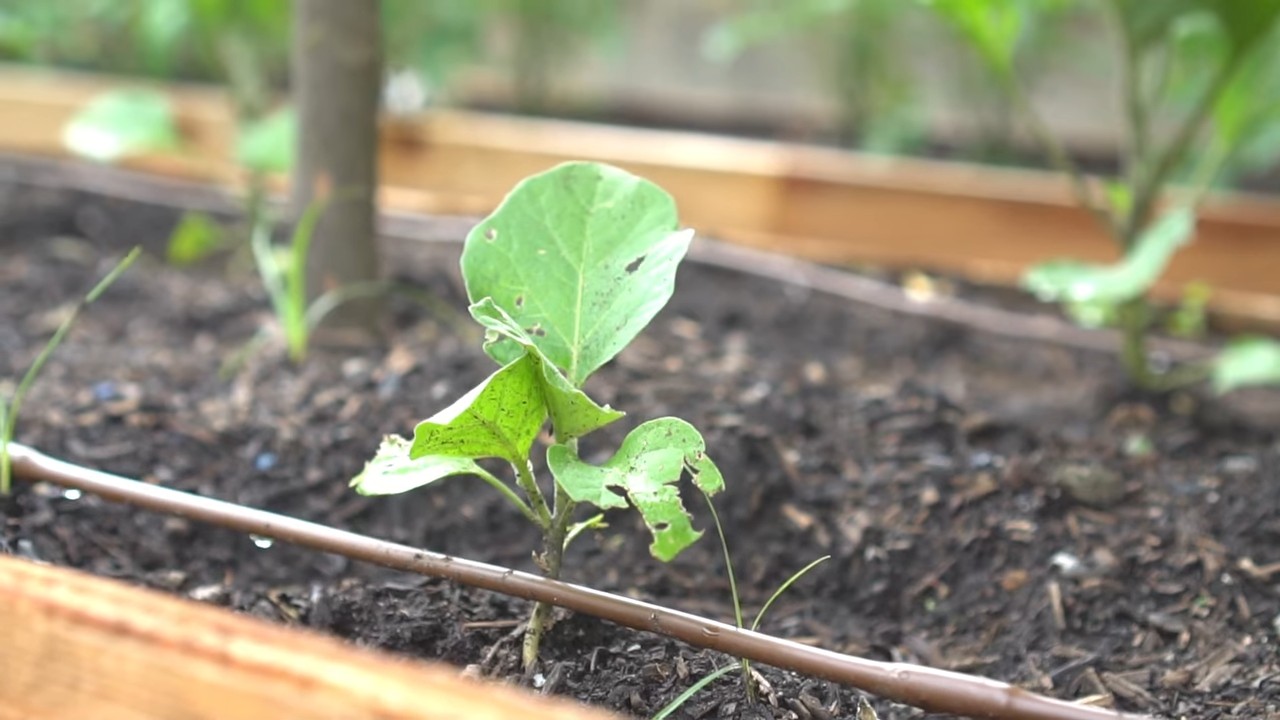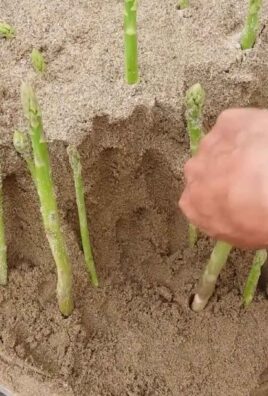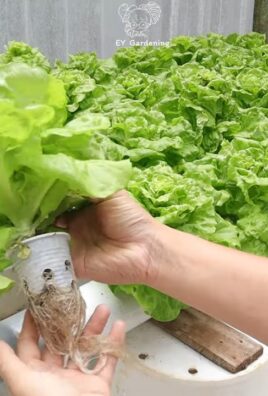Grow Eggplant at Home and unlock the secrets to a bountiful harvest right in your backyard! Imagine plucking plump, glossy eggplants fresh from your own garden, ready to be transformed into delicious meals. Forget those bland, store-bought varieties – with a few simple tricks, you can cultivate eggplants bursting with flavor and vibrant color.
Eggplants, also known as aubergines, have a rich history, tracing back to ancient Asia where they were first cultivated. Over centuries, they’ve journeyed across continents, becoming a staple in cuisines worldwide, from the Mediterranean to the Far East. Growing your own connects you to this long and delicious tradition!
Why should you learn these DIY eggplant growing hacks? Well, for starters, it’s incredibly rewarding to nurture a plant from seedling to harvest. Plus, you’ll know exactly what’s going into your food – no harmful pesticides or mystery ingredients. But more importantly, mastering how to grow eggplant at home means you’ll have a consistent supply of this versatile vegetable, ready for grilling, roasting, or adding to your favorite curries. I’m excited to share some easy-to-follow tips and tricks that will help you achieve eggplant-growing success, even if you’re a complete beginner. Let’s get started!

Growing Eggplants at Home: Your DIY Guide for a Bountiful Harvest
Hey garden friends! Have you ever dreamed of harvesting your own plump eggplants in the garden or even on the balcony? I can tell you, it’s easier than you think and incredibly satisfying! In this article, I’ll show you step by step how to successfully grow your own eggplants. Let’s get started!
The Basics: What Eggplants Love
Eggplants are little divas when it comes to their needs. But don’t worry, I’ll share their secrets with you:
-
Sun, Sun, Sun: Eggplants love the sun! They need at least 6-8 hours of direct sunlight per day to thrive properly.
-
Warmth: They are sensitive to frost and like it warm. The ideal temperature is between 21°C and 29°C (70°F and 85°F).
-
Good Soil: Eggplants need well-draining, fertile soil with a pH between 6.0 and 6.8.
-
Regular Watering: They don’t like to dry out, so keep the soil moist, but not soggy.
-
Nutrients: Eggplants are hungry! They need regular feedings of fertilizer to produce a lot of fruit.
Phase 1: Starting Seeds (Starting Indoors)
Since eggplants have a long growing season, it is advisable to start them indoors, especially if you live in a region with shorter summers. I usually start about 8-10 weeks before the last expected frost date.
1. Sowing Seeds:
-
Fill small seedling pots or a seed tray with seed starting mix.
-
Make small holes (approx. 1 cm deep) in the soil.
-
Place 2-3 seeds in each hole. This increases the likelihood that at least one will germinate.
-
Lightly cover the seeds with soil and water them gently.
-
Important: Label your pots! Believe me, you’ll be glad later when you know which variety is growing where.
2. Providing Warmth:
-
Eggplant seedlings need warmth to germinate. The ideal germination temperature is between 24°C and 29°C (75°F and 85°F).
-
You can place a heating mat under the seed tray to raise the temperature.
-
Alternatively, you can place the pots in a warm place, e.g., near a heater or on a windowsill above a radiator.
3. Maintaining Moisture:
-
The soil should be kept moist during germination.
-
Use a spray bottle to moisten the soil regularly. Avoid overwatering, as this can lead to mold.
-
A clear plastic cover or a mini-greenhouse can help retain moisture.
4. Be Patient:
-
Germination can take 1-2 weeks. Be patient and don’t give up!
-
As soon as the seedlings appear, remove the plastic cover and place them in a bright spot.
5. Thinning Out:
-
Once the seedlings are a few centimeters tall, thin them out by cutting off the weakest seedling in each pot.
-
Leave only the strongest seedling per pot.
Phase 2: The Repotting Phase
When the seedlings are large enough and have a few true leaves (not just the seed leaves), it’s time to repot them into larger pots.
1. Preparing Larger Pots:
-
Choose pots with a diameter of at least 10 cm (4 inches).
-
Fill the pots with high-quality potting soil.
2. Carefully Repotting Seedlings:
-
Gently loosen the soil in the seedling pots.
-
Carefully lift the seedlings out of the pots with a spoon or a small trowel. Be careful not to damage the roots.
-
Place the seedlings in the new pots and fill the pots with soil.
-
Water the seedlings gently.
3. Continuing Care:
-
Place the repotted seedlings in a bright place and water them regularly.
-
Start fertilizing them with a diluted liquid fertilizer.
Phase 3: Hardening Off and Planting Out
Before you plant your eggplants outdoors, you need to harden them off. This means slowly acclimatizing them to outdoor conditions.
1. Hardening Off:
-
Start about a week before the planned planting-out date.
-
Place the eggplants outdoors for a few hours a day in a sheltered spot.
-
Increase the time outdoors by a few hours each day.
-
Bring the eggplants back indoors at night.
2. Planting Out:
-
Choose a sunny location with well-draining soil.
-
The soil should be warm (at least 15°C / 60°F).
-
Plant the eggplants 45-60 cm (18-24 inches) apart.
-
Dig holes large enough to accommodate the root balls.
-
Place the eggplants in the holes and fill the holes with soil.
-
Water the eggplants thoroughly.
-
Tip: Mix some compost or well-rotted manure into the planting hole to improve the soil.
3. Providing Support:
-
Eggplant plants can get heavy when they bear fruit.
-
Use stakes or cages to support the plants and prevent them from falling over.
Phase 4: Outdoor Care
Now that your eggplants are outdoors, it’s important to take good care of them to get a bountiful harvest.
1. Watering:
-
Eggplants need regular watering, especially during dry periods.
-
Water the plants deeply and regularly, but avoid wetting the leaves, as this can lead to fungal diseases.
-
Tip: Use mulch to retain moisture in the soil and suppress weeds.
2. Fertilizing:
-
Eggplants are hungry! Fertilize them every 2-3 weeks with a balanced liquid fertilizer.
-
You can also use organic fertilizers like compost tea or diluted fish emulsion.
3. Pests and Diseases:
-
Eggplants can be affected by various pests and diseases, such as aphids, potato beetles, and fungal diseases.
-
Check the plants regularly for pests and diseases.
-
Remove affected leaves or plants.
-
Use organic pesticides or fungicides if necessary.
4. Pruning Suckers:
-
Some eggplant varieties benefit from having their suckers pruned.
-
Remove the side shoots that grow between the main stem and the leaves.
-
Pruning suckers encourages the formation of larger fruits.
5. Pollination:
-
Eggplants are self-pollinating, but insects like bees can improve pollination.

Conclusion
So, there you have it! Growing eggplant at home isn’t just a gardening project; it’s an investment in flavor, freshness, and a deeper connection with your food. Forget those bland, often waxed eggplants from the grocery store. Imagine biting into a perfectly ripe, sun-warmed eggplant that you nurtured from seed to table. The difference in taste and texture is truly remarkable.
This DIY approach to growing eggplant offers a level of control you simply can’t achieve with store-bought produce. You get to choose the variety that best suits your taste and climate, ensuring a harvest of eggplants that are perfectly tailored to your culinary preferences. Want a classic Italian eggplant for your parmigiana? Go for it! Craving the smoky sweetness of a Japanese eggplant for grilling? Plant away! The possibilities are endless.
Beyond the superior flavor, growing your own eggplant is also incredibly rewarding. There’s a unique satisfaction in watching a tiny seed transform into a thriving plant, laden with beautiful, glossy eggplants. It’s a tangible connection to the natural world, a reminder of the simple joys of life. Plus, you’ll be reducing your carbon footprint by cutting down on transportation and packaging.
But the benefits don’t stop there. Growing eggplant at home can also be a cost-effective way to enjoy this versatile vegetable. While the initial investment in seeds, soil, and perhaps a few supplies might seem daunting, the yield from even a few plants can easily offset those costs, especially if you’re a frequent eggplant eater.
Ready to take your eggplant game to the next level? Don’t be afraid to experiment! Try different varieties, explore companion planting techniques, and adjust your watering and fertilizing schedule based on your local climate and soil conditions. Consider growing your eggplants in containers if you have limited space or want to move them indoors during colder months. You can also try succession planting, sowing new seeds every few weeks to ensure a continuous harvest throughout the growing season.
And speaking of variations, why not try grafting your eggplant onto a more vigorous rootstock? This can significantly improve disease resistance and yield, especially in challenging growing conditions. Or, if you’re feeling adventurous, try growing some of the more unusual eggplant varieties, such as the Thai green eggplant or the fairytale eggplant.
We’re confident that you’ll find growing eggplant at home to be a fun, rewarding, and delicious experience. So, grab your gardening gloves, get your hands dirty, and prepare to be amazed by the bounty you can create.
We encourage you to share your experiences with us! Post photos of your eggplant plants, share your favorite recipes, and let us know what challenges you encountered and how you overcame them. Together, we can create a community of passionate eggplant growers, sharing tips and tricks to help everyone succeed. Let us know what kind of fertilizer you used, what kind of soil you used, and what kind of pest control you used. Your insights could be invaluable to other aspiring gardeners. Happy growing!
Frequently Asked Questions (FAQ)
What are the best eggplant varieties to grow at home?
The best eggplant variety depends on your climate, growing space, and personal preferences. For beginners, classic varieties like ‘Black Beauty’ are a reliable choice, offering good yields and disease resistance. If you have limited space, consider compact varieties like ‘Patio Baby’ or ‘Fairy Tale.’ For warmer climates, Japanese eggplants like ‘Ichiban’ or ‘Long Purple’ are excellent choices. If you’re looking for something unique, try ‘Thai Green’ or ‘Rosa Bianca.’ Research the specific needs of each variety to ensure it’s well-suited to your growing conditions. Consider disease resistance as well, especially if you’ve had problems with fungal diseases in the past.
How much sunlight do eggplants need?
Eggplants are sun-loving plants and require at least 6-8 hours of direct sunlight per day to thrive. Insufficient sunlight can lead to leggy growth, poor fruit production, and increased susceptibility to pests and diseases. Choose a location in your garden that receives full sun throughout the day. If you’re growing eggplants in containers, make sure to place them in a sunny spot or supplement with grow lights if necessary.
What kind of soil is best for growing eggplants?
Eggplants prefer well-drained, fertile soil that is rich in organic matter. The ideal soil pH is between 6.0 and 6.8. Before planting, amend your soil with compost, aged manure, or other organic materials to improve drainage, fertility, and water retention. Avoid heavy clay soils, as they can become waterlogged and inhibit root growth. If you have clay soil, consider growing your eggplants in raised beds or containers with a well-draining potting mix.
How often should I water my eggplants?
Eggplants need consistent moisture, especially during hot weather and fruit development. Water deeply and regularly, aiming to keep the soil consistently moist but not waterlogged. Check the soil moisture regularly by sticking your finger about an inch into the soil. If it feels dry, it’s time to water. Avoid overhead watering, as this can promote fungal diseases. Instead, water at the base of the plant, using a soaker hose or drip irrigation system. Mulching around the plants can also help to retain moisture and suppress weeds.
What are some common pests and diseases that affect eggplants?
Eggplants are susceptible to a variety of pests and diseases, including aphids, flea beetles, spider mites, tomato hornworms, and fungal diseases like verticillium wilt and early blight. Regularly inspect your plants for signs of pests or diseases. Use organic pest control methods, such as insecticidal soap, neem oil, or hand-picking, to control infestations. To prevent fungal diseases, ensure good air circulation, avoid overhead watering, and apply a fungicide if necessary. Choose disease-resistant varieties whenever possible. Crop rotation can also help to reduce the buildup of soilborne pathogens.
When should I harvest my eggplants?
Eggplants are typically ready to harvest 65-80 days after transplanting, depending on the variety. The fruit should be firm, glossy, and have a deep, even color. Gently press the skin of the eggplant; if it springs back slightly, it’s ripe. Overripe eggplants will become dull, soft, and bitter. Use a sharp knife or pruning shears to cut the eggplant from the plant, leaving a short stem attached. Harvest regularly to encourage continued fruit production.
Can I grow eggplants in containers?
Yes, eggplants can be successfully grown in containers, making them a great option for gardeners with limited space. Choose a large container, at least 12-18 inches in diameter, to provide adequate room for root growth. Use a well-draining potting mix and ensure the container has drainage holes. Water regularly and fertilize every 2-3 weeks with a balanced fertilizer. Place the container in a sunny location that receives at least 6-8 hours of direct sunlight per day.
What is the best fertilizer for eggplants?
Eggplants benefit from regular fertilization to support healthy growth and fruit production. Use a balanced fertilizer with a ratio of 10-10-10 or 14-14-14. Apply fertilizer according to the package directions, typically every 2-3 weeks. You can also supplement with organic fertilizers, such as compost tea or fish emulsion. Avoid over-fertilizing, as this can lead to excessive foliage growth and reduced fruit production.
How can I prevent blossom end rot in eggplants?
Blossom end rot is a common problem in eggplants, caused by a calcium deficiency. To prevent blossom end rot, ensure your soil has adequate calcium levels. Amend your soil with lime or bone meal before planting. Water consistently to maintain even soil moisture, as fluctuations in moisture can interfere with calcium uptake. You can also apply a calcium foliar spray to the plants. Avoid over-fertilizing with nitrogen, as this can also contribute to blossom end rot.
Can I save seeds from my eggplants?
Yes, you can save seeds from your eggplants, but it’s important to note that hybrid varieties may not produce true-to-type offspring. To save seeds, allow the eggplant to fully ripen on the plant until it becomes dull and slightly soft. Cut the eggplant open and scoop out the seeds. Rinse the seeds thoroughly to remove any pulp. Spread the seeds out on a paper towel to dry completely. Store the dried seeds in an airtight container in a cool, dark place.





Leave a Comment